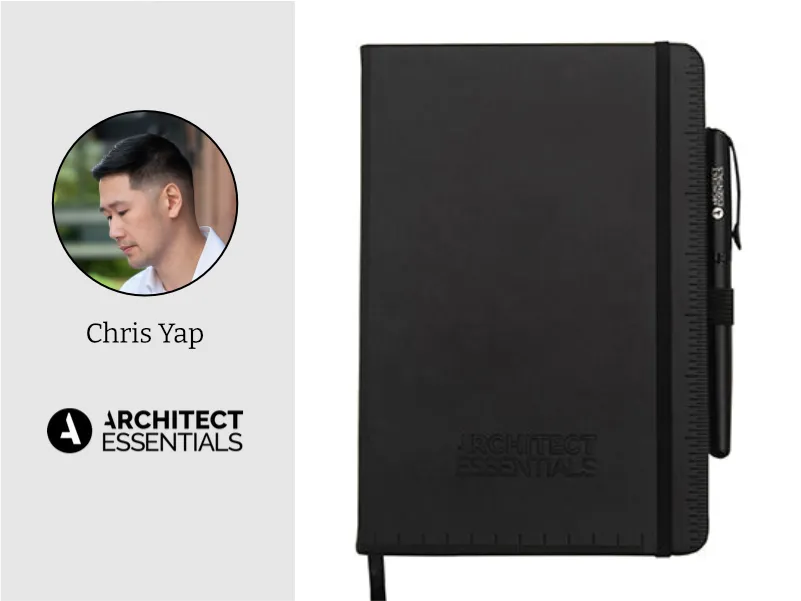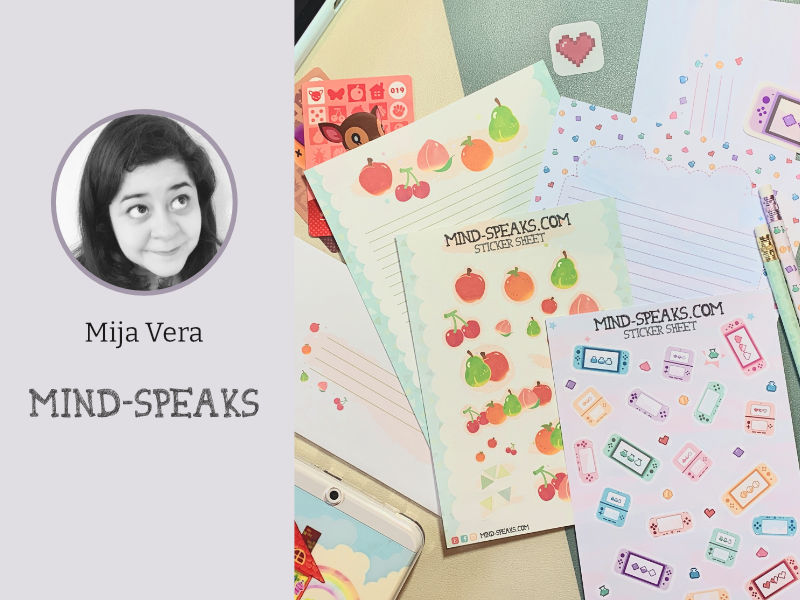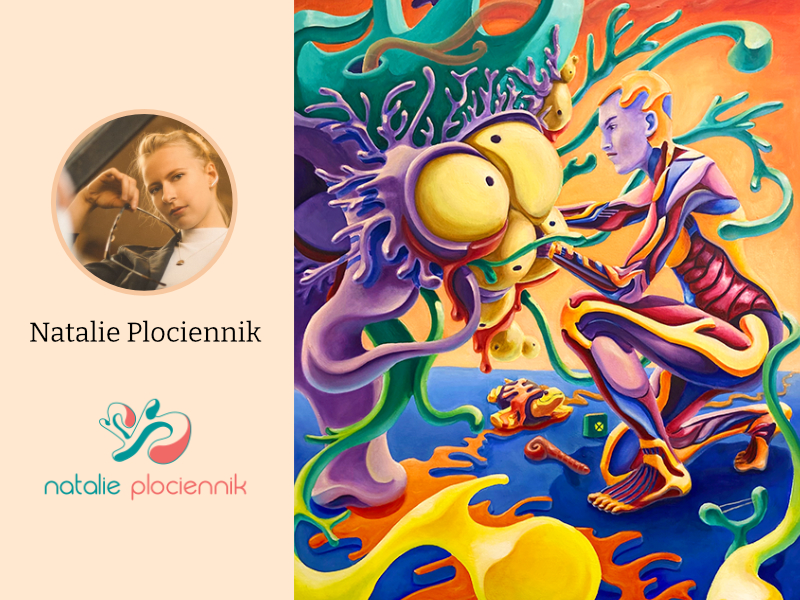
Founder Stories is a series that features creative entrepreneurs who run product-based businesses. The conversations will explore their story, their business, and show the little, hidden moments that happen behind the scenes.
Chris Yap is an intern architect from Toronto who founded Architect Essentials . He launched a Kickstarter in the summer of 2021 to fund a sketchbook for architects. The fundraiser was fully backed with 67 backers who pledged a total of $5,457. I was extremely impressed with how Chris listened closely to the architect community and created a product that respected their needs. See the full interview below for more insights about manufacturing and product launch.
If you prefer to listen or watch this interview, you can
watch it here
.
Could you please introduce yourself?
My name is Chris. I'm an intern architect working towards getting my licence in Toronto. I started a Kickstarter for sketchbooks that I designed specifically for architects initially, but then kind of expanded that out into other design professions as well. At the beginning of the pandemic, I started doing some design competitions just to do something more creative. In the architecture industry, there's a lot of work behind the scenes that aren't too creative. I wanted to do something that got those juices flowing again, instead of coordinating door schedules and window details and stuff like that. So, it was really when I started doing design competitions again that I got back into hand sketching, which is something I hadn't done much of after graduating from university. Most of the work is digital and is computer based, we draw and model on the computer now. So, when I started sketching again, I started going through a bunch of different sketchbook brands, I used a lot of Moleskines and Leuchtturm in university, and then some other sketchbooks. There were a couple other sketchbooks that were designed by architecture students or by architects, but I don't think many of them produce sketchbooks anymore. So, I didn't get an opportunity to test them out.
"Paper quality was the biggest thing that designers tend to look for. And that’s why when I had these made, I pushed the manufacturer to make the sketchbooks with 120-gsm thick paper, it’s heavier quality paper."
Through using all these sketchbooks, I kind of had an idea of what I wanted in a sketchbook. I started looking into how I could potentially make my own sketchbook or a sketchbook for designers and architects. As an architect, we tend to use various mediums. One day we might be drawing in pencil, another day, we might be using fine liner or alcohol markers. Some even like to use watercolours. Some of those mediums work in a Moleskine, but I didn't think that the paper quality could stand up to like alcohol markers. So, I wanted to see if I could get a sketchbook made that could handle all those mediums. There are a few other qualities in sketchbooks that I liked, I like the multiple ribbons that some sketchbooks provide. Throughout this journey I talked to a lot of designers, architects to get their thoughts on a sketchbook. I had feedback from probably just over 100 architects and designers. I had sent out surveys and talked to a bunch of them in person just to see what size of a sketchbook they typically look for and what qualities in a sketchbook they look for. Paper quality was the biggest thing that designers tend to look for. And that's why when I had these made, I pushed the manufacturer to make the sketchbooks with 120-gsm thick paper, it's heavier quality paper. Another thing that architects like to do is, you might take your sketchbook on-site or you'd be working with another architect or designer and you might sketch something and want to hand that over to them. A lot of these glue and stitch bound sketchbooks, the bindings start to get destroyed if you start ripping out pages and so we looked at a way that it could perforate the pages to make it easy for people to take out the pages in the sketchbooks. That was another design quality that I was looking to put in a sketchbook and it took a long time to find the right manufacturer that could do that. But in the end, I'm pretty happy with how the sketchbooks turned out. I guess that's the general idea of how I came about making these sketchbooks.
"Initially, I tried to over design the sketchbook and I had to take a step back and address the main concerns and keep it simple, a lot of designers and architects don’t actually want you to design too much for them, because they’re the designer, so they like the blank slate."
When you identified the challenges you had, which was finding the right sketchbook for your own use, did you find that the design community identified with the same problem you had?
A lot of them did. The one thing about doing something or creating a product for an industry that's heavily involved in design, is a lot of them have their own opinions. So, part of the challenge was trying to suss out all the different opinions and try to adjust or address a majority of the issues that people bring up with the sketchbooks that they use, and try to encapsulate that. What I did find helpful was talking to a lot of people, because the issues that I had are not necessarily qualities that the architecture community in the whole really looked for. Initially, I tried to over design the sketchbook and I had to take a step back and address the main concerns and keep it simple, a lot of designers and architects don't actually want you to design too much for them, because they're the designer, so they like the blank slate. But if you can give them a quality product, then they're happy with that. There was a balance between designing a sketchbook for designers, but also not over designing the product to the point where they didn't want to use it, because they have their own design ideas for what they want to do in the sketchbook.
You really listened to the community, which is really good, especially when designing a product from scratch. A lot of new founders have challenges even finding these people. How did you find people to get product feedback?
The first and I think most obvious thing is that I'm in the industry. I talked to co-workers, but also the education process to become an architect is pretty long, you do a four-year undergrad degree and then a minimum of two years for your masters. I was fortunate enough to do my undergrad in Winnipeg, Manitoba, and then do my masters in Calgary, Alberta, and then work in Toronto. So, I had an opportunity to meet and network with people across the country. I guess that's one of the nice things about social media is even though I haven't talked to most of them in maybe four-years, I'm friends with them on Facebook, I just message old classmates and other designers that I've met throughout the years and talk to them. That was the first kind of phase of discussing this idea with other designers and seeing what their opinions were.
"...the first batch of a small run of 50 sketchbooks didn't turn out the way I had hoped. They weren't the quality that I expected. When I finally received them...I was kind of disappointed by it. And so, I had launched it for a couple of days and just took it off because I wasn't happy with the quality of the product. I think that was me trying to move too fast too. So, from that I learned what to look for in a manufacturer and there's a lot of logistics that I had to figure out..."
The second thing was to get an idea of the manufacturing process, and dealing with the logistics of working with a manufacturer overseas compared to in Canada, which is a whole other thing. I had a first test batch of sketchbooks made. It actually became my way of understanding how to work with an overseas manufacturer in a different country and finding the right manufacturer to produce a quality product. So, the first batch of a small run of 50 sketchbooks which didn't turn out the way I had hoped. They weren't the quality that I expected. When I finally received them, I had gotten ready to launch the product. And then when I got them, I was kind of disappointed by it. And so, I had launched it for a couple of days and just took it off because I wasn't happy with the quality of the product. I think that was me trying to move too fast too. So, from that I learned what to look for in a manufacturer and there's a lot of logistics that I had to figure out and then when I finally got the manufacturing down, that's when I made a push to the community to see what they look for in a sketchbook and I actually use that first batch as an advertising means to reach out to other designers and I just offered it to them. It's not the best quality sketchbook but I have these free sketchbooks that I'm willing to send out to people. All you have to do is give me feedback on what you look for in a sketchbook, what you don't like in the sketchbook that I sent to you, and well, this is really just a test and a study to see what do you guys actually want in a sketchbook.
It seems you made a good thing out of something that was sort of unfortunate.
Yeah.
When I looked at your Kickstarter, you launched it, I believe in June, but you got it fully backed in July. But then there's this process before that, which was you went through this whole phase of learning about manufacturing. So, it seems like you had a really good run the first time, but that's not true. You had couple of ups and downs.
Yeah, for sure. And even the second run of dealing with logistics was kind of challenging. With the Kickstarter, I was certain that I was going to have them made by a certain day, and I could do quality control, check them all before sending them out to people. But that got backed up. I actually ended up having the manufacturer fly the Kickstarter orders to me, because they were two months behind. I didn't want people to keep waiting for these sketchbooks. And then once I did a quality control of them, there were a lot of quality issues. For a third of the sketchbooks, I had to ask them to remake because there were a lot of quality issues, because they were dealing with manufacturing issues like power supply to the manufacturer and stuff. But luckily, they're working with me and they're remaking those books. So that was also a challenge that I didn't expect would happen.
How did you identify manufacturers? Did you just search them up?
Yeah, I think the short answer is just I went on Alibaba, talk to a bunch of manufacturers there. And then, it required quite a bit of research online to find the right manufacturing. I watched a bunch of videos and read a bunch of blogs, but there are certain things that you look for, such as where they're located. And then there are ways to tell if they're a middleman or if they're the actual direct manufacturer. There are ways to see how big of a manufacturing plant they have. And so that was something I didn't figure out until the Kickstarter run. In my initial run, I was probably dealing with a middleman, but I didn't know that was the case. And so, there's things that you have to look out for, like the way the company is named. In China, you can figure out what their main product that they produce is. So, if they have paper in their name, then they're generally a paper company. There's a specific way that they have to name their business in China to get their licence.
How did you find out if they were a middle person? Was there a trick to that?
You can tell generally by the number of employees that they have, and they have to state how many employees they have. But that wasn't something I looked out for during my first small order of sketchbooks that I wasn't happy about. The manufacturer I am currently working with had 250 to 500 people working there, so you kind of know that they're a manufacturer that way. They also have their certificates posted on their Alibaba manufacturing site, to that show that Alibaba has gone there in-person and actually vetted the company.
For your first run, did you do that out of your own pocket, or did you also run a Kickstarter for that?
Oh, that was out of my own pocket.
With the second run that got delayed and had to some of the sketchbooks remade, did you have to reach out to the people who backed it or did you just eat that cost?
So, the nice thing about Kickstarter is it's a way to gauge some of the interest that you have in your product. I'm happy with the product I came up with, with all the samples I had made and sent to me. And then instead of going the route of just ordering 500 or 1000 sketchbooks from the manufacturer, and putting that money upfront… and so Kickstarter is nice because people put money down before you actually have the products made. Once I had the Kickstarter fully backed, I actually doubled up the order, so that I would have additional books that I could start marketing and selling and bring to stores. I had one local store that said that they would buy the product once I had it, but they weren't going to actually put money towards the Kickstarter, because they didn't want to put the money down upfront. I knew that generally there's going to be some quality control issues that you have to do when you're ordering a large number of products. So, I also had that contingency just as a buffer in case something went wrong. Or, you know, maybe a box of books got lost during shipping or something.
Yeah, anything can happen.
Yeah, so the Kickstarter was nice, because it helped me put down the order for them. It allowed me to not pay too much out of pocket to order additional supply if I wanted. I guess the benefit to that was that there were a number of books that I couldn't send out to people. But because I had ordered more than I needed, I was able to make sure that everybody got a quality product.
When you started this Kickstarter, was that the first thing that came to mind as you're planning to build the sketchbook or like, how did you come to the idea of using Kickstarter?
No, initially, I have played around a little bit with online advertising through Facebook and Instagram. Initially, I wanted to create my own shop and do it that way. But I found that to be quite an expensive way to find my market and target audience. So I figured I could probably reach out to my community first that I know firsthand to see if there's interest that way. And hopefully, that kind of trickles throughout more of the community through them, whether they're sharing my posts or whatnot, as opposed to just going directly to online advertising and paying out of pocket for that. I initially tried a little bit of online ads, and it became a pretty expensive experiment with Facebook, Instagram, Pinterest. I also tried Google ads, YouTube ads, LinkedIn. And I did play around a little bit of that for the Kickstarter, but it wasn't actually too fruitful. The challenge with Kickstarter was a lot of people didn't know what Kickstarter was. I had to walk people through Kickstarter too. I eventually decided to go the Kickstarter route just to gauge interest before spending a lot of money through online advertising. I thought it would be a way for me to gauge the audience without having to spend a lot of money upfront that I didn't have, to see if the product would work or not.
"A big part of running a Kickstarter is that a lot of people who initially back the project are going to be within your network."
So, what was it like for you to be fully backed? Did you run ads? You said ads didn't quite work for you. How did you get to that point of being fully backed?
Yeah, so I ran a bunch of ads, but I don't think they were very successful. I would say 90% of the people who backed the project were people within my network. A big part of running a Kickstarter is that a lot of people who initially back the project are going to be within your network. For most successful campaigns, at least. I think mine was way over the typical amount of people who would back your project from your network. But halfway through the campaign, I realised that if it was going to be successful, it was going to be people from my network. So, I began doing direct reach outs to people and who I went to school with, who are architects now and previous coworkers from other offices that I had worked for in the past. And that ended up helping quite a bit in terms of getting the project backed.
Wow, that's really interesting, because it says a lot about trust. They know you, they trust you, they trust you're doing a good job. But when you try to run ads, complete strangers, it's a lot harder to make that sale.
Yeah, for sure, it feels almost indirect, I did get some people who backed the project through just posting on Facebook or LinkedIn communities, too. And I feel like that's almost more of a direct connection to people than just running an ad on a website as well. So that became like a secondary source. I'm not going to lie, friends and family also helped out when they saw that I was running the campaign. So, it helps because it gets the project off the ground, but it's also something that you can't rely on going down the road. Because they're not really the target audience. For example, my uncle who contributed to Kickstarter isn't necessarily who I would target going down that road, but it's nice that they want to help out too. That’s also the nice thing about Kickstarter is it gives you time to figure out how you can reach your audience. I felt like it was a helpful tool for me to understand who I was trying to market to, and how to find them, and test different things out while I was running the Kickstarter.
"I found sketching as a tool brings me back to a lot of what I enjoyed about my education and profession. Part of making the sketchbooks was to remind myself and other designers and architects that sketching is still a useful tool that we can use."
Why do you do what you do?
So, as I said, In the beginning, this idea came from when I started doing design competitions, and started hand sketching again. It really reminded me about how much I used hand sketching, but also like building physical models in architecture school, as a tool to think through design, understand what I'm doing. And it was something I forgot about when I started working in the industry, because everything is on the computer. Once I started hand sketching again, I realised how useful of a tool it can be for me to think through things, as opposed to trying to always draw something on a computer screen or even explaining an idea or a thought to a co-worker. Sometimes it's just easier to sketch it by hand to say this is what I was thinking or this is how I think the canopy should look because of this, or even working through an architectural detail of how a wall assembly goes together. I found sketching as a tool brings me back to a lot of what I enjoyed about my education and profession. Part of making the sketchbooks was to remind myself and other designers and architects that sketching is still a useful tool that we can use. I know a lot of the professions have gone digital and nobody draws floor plans or building elevations by hand anymore, but it’s still a very useful tool to think through design for a project. These sketchbooks also became a creative outlet, a way for me, in my current position as an intern architect, to contribute to the architectural community, without working 20 years to become a partner at an office. This is a little bit of me trying to find a way to contribute to the community now, as opposed to just working in an office until I make it to a more senior position. I’m kind of controlling my input into the design community as well. Because until you become a project manager or a senior architect in an office, you don't really get to control as much of the design process as you'd like. So, making my own sketchbooks became a way for me to be creative while contributing to the community.
Thank you for your time, Chris.
Thanks for the interview, Jane. I enjoyed it.
Comments




